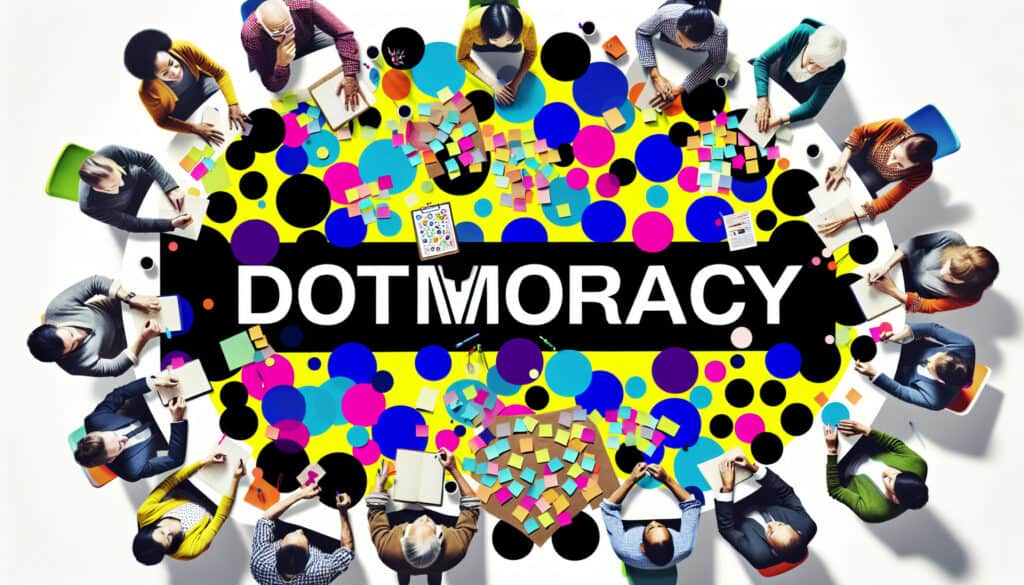A simple facilitation method used to help a large group of people prioritize a list of options democratically and visually.
- Methodologies: Ergonomics
Dotmocracy

Dotmocracy
- Agile Methodology, Continuous Improvement, Design Thinking, Ideation, Innovation, Project Management, Teamwork, User-Centered Design
Objective:
How it’s used:
- After a list of ideas is generated and posted on a wall, each participant is given a small number of stickers (dots). They then place their dots on the options they prefer, allowing the group to quickly see which ideas have the most support.
Pros
- Is a very simple, fast, and transparent way to gauge group consensus; is highly democratic and encourages equal participation; provides a clear visual summary of priorities.
Cons
- Can lead to 'groupthink' where people are influenced by where others have placed their dots; does not allow for discussion or nuance about why an option is preferred.
Categories:
- Ideation, Problem Solving, Project Management
Best for:
- Quickly and democratically prioritizing a list of ideas in a group setting using stickers or dots.
Dotmocracy is particularly beneficial in environments where collaborative decision-making is fundamental, such as in design thinking workshops, community engagement projects, and corporate brainstorming sessions. Industries such as product development, urban planning, and educational program design frequently utilize this methodology, especially in the conceptual phases where diverse viewpoints are essential to inform the direction of a project. Participants in a Dotmocracy session may include designers, engineers, project stakeholders, and end-users, allowing for a rich cross-section of opinions that can enhance the idea generation process. This method is adaptable across various contexts, from initial idea generation phases to concluding evaluations of proposed solutions, providing a clear framework for collective prioritization. The visual representation of dots on ideas creates an immediate understanding of consensus within the group, making it easy to identify which concepts resonate most strongly with participants. This rapid form of evaluation not only speeds up decision-making but also increases engagement, as everyone has an equal opportunity to weigh in on the options presented. It is particularly useful in settings where time is limited and quick feedback loops are required, allowing teams to pivot based on collective preferences without extensive debates or prolonged discussions. Using tools like sticky notes or digital platforms that simulate this process, organizations can maintain transparency and inclusiveness while ensuring that all voices are heard in the early stages of product design and development.
Key steps of this methodology
- Present the list of generated ideas for all participants to see.
- Distribute a limited number of stickers or dots to each participant.
- Allow participants to place their dots on the ideas they prefer.
- Identify the ideas with the highest number of dots as the most supported.
- Discuss the top ideas based on the dot placement for further exploration.
Pro Tips
- Encourage participants to cluster similar ideas before dot voting, enhancing clarity and reducing redundancy in the options presented.
- Limit the number of dots per participant to avoid skewed results from dominant voices; this fosters more balanced input across the group.
- After voting, facilitate a brief discussion to understand the reasoning behind selections, which can uncover deeper insights into group priorities.
To read and compare several methodologies, we recommend the
> Extensive Methodologies Repository <
together with the 400+ other methodologies.
Your comments on this methodology or additional info are welcome on the comment section below ↓ , so as any engineering-related ideas or links.
Historical Context
1960
1980
1983
1990
1995
2000
2010
1950
1980
1980
1986
1994
1995
2000
(if date is unknown or not relevant, e.g. "fluid mechanics", a rounded estimation of its notable emergence is provided)














Related Posts
Monte Carlo Simulation
Model-Based Testing
Model Checking
Mixed Methods Research
Mistake Proofing (Poka-Yoke)
Mission Profile Testing